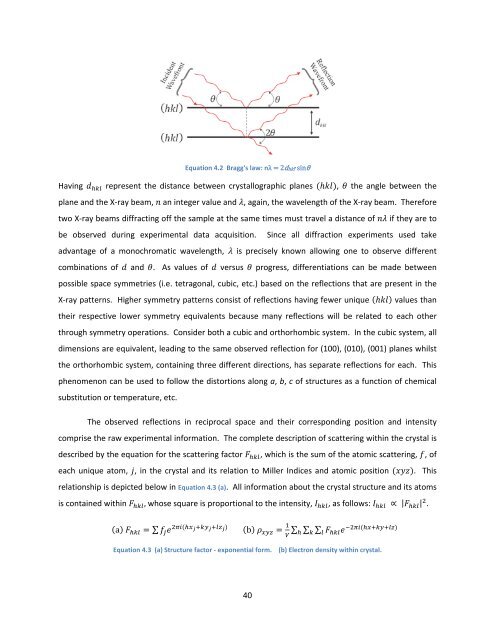Exploration and Optimization of Tellurium‐Based Thermoelectrics
Exploration and Optimization of Tellurium‐Based Thermoelectrics
Exploration and Optimization of Tellurium‐Based Thermoelectrics
You also want an ePaper? Increase the reach of your titles
YUMPU automatically turns print PDFs into web optimized ePapers that Google loves.
Equation 4.2 Bragg's law: nλ 2dhkl·sinθ<br />
Having represent the distance between crystallographic planes , the angle between the<br />
plane <strong>and</strong> the X‐ray beam, an integer value <strong>and</strong> , again, the wavelength <strong>of</strong> the X‐ray beam. Therefore<br />
two X‐ray beams diffracting <strong>of</strong>f the sample at the same times must travel a distance <strong>of</strong> if they are to<br />
be observed during experimental data acquisition. Since all diffraction experiments used take<br />
advantage <strong>of</strong> a monochromatic wavelength, is precisely known allowing one to observe different<br />
combinations <strong>of</strong> <strong>and</strong> . As values <strong>of</strong> versus progress, differentiations can be made between<br />
possible space symmetries (i.e. tetragonal, cubic, etc.) based on the reflections that are present in the<br />
X‐ray patterns. Higher symmetry patterns consist <strong>of</strong> reflections having fewer unique values than<br />
their respective lower symmetry equivalents because many reflections will be related to each other<br />
through symmetry operations. Consider both a cubic <strong>and</strong> orthorhombic system. In the cubic system, all<br />
dimensions are equivalent, leading to the same observed reflection for (100), (010), (001) planes whilst<br />
the orthorhombic system, containing three different directions, has separate reflections for each. This<br />
phenomenon can be used to follow the distortions along a, b, c <strong>of</strong> structures as a function <strong>of</strong> chemical<br />
substitution or temperature, etc.<br />
The observed reflections in reciprocal space <strong>and</strong> their corresponding position <strong>and</strong> intensity<br />
comprise the raw experimental information. The complete description <strong>of</strong> scattering within the crystal is<br />
described by the equation for the scattering factor , which is the sum <strong>of</strong> the atomic scattering, , <strong>of</strong><br />
each unique atom, , in the crystal <strong>and</strong> its relation to Miller Indices <strong>and</strong> atomic position . This<br />
relationship is depicted below in Equation 4.3 (a). All information about the crystal structure <strong>and</strong> its atoms<br />
is contained within , whose square is proportional to the intensity, , as follows: ∝ | | .<br />
a ∑ b <br />
∑ ∑ ∑ <br />
<br />
Equation 4.3 (a) Structure factor ‐ exponential form. (b) Electron density within crystal.<br />
40
















